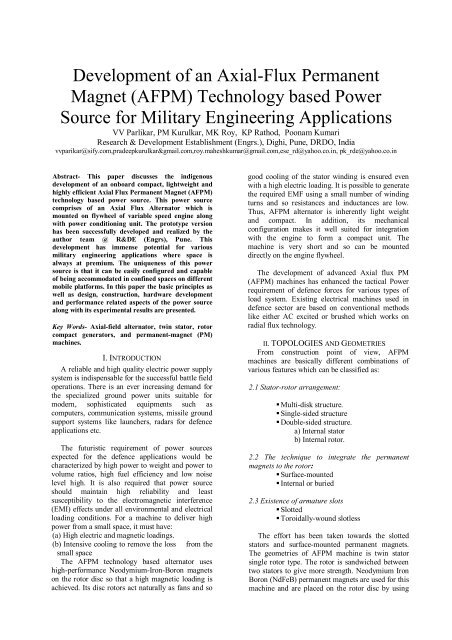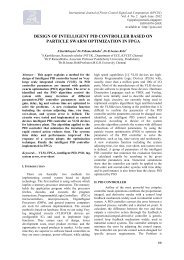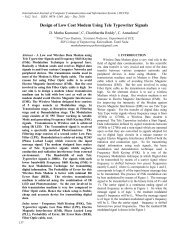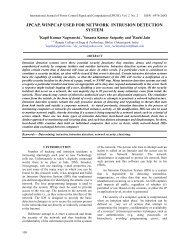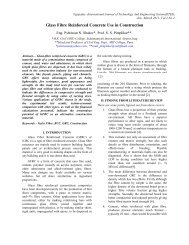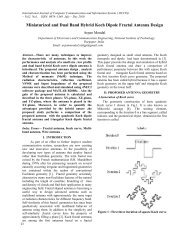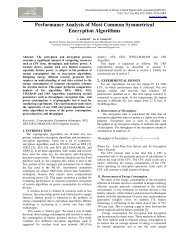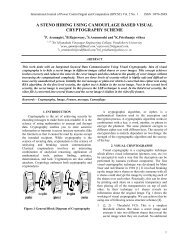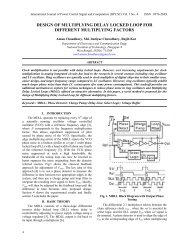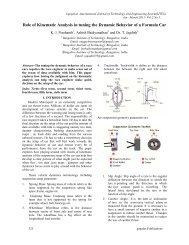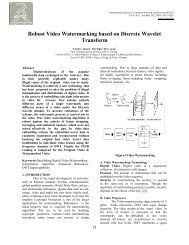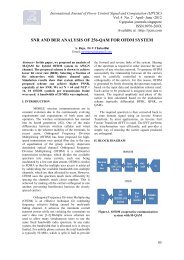Development of an Axial-Flux Permanent Magnet (AFPM ... - Ijcns.com
Development of an Axial-Flux Permanent Magnet (AFPM ... - Ijcns.com
Development of an Axial-Flux Permanent Magnet (AFPM ... - Ijcns.com
Create successful ePaper yourself
Turn your PDF publications into a flip-book with our unique Google optimized e-Paper software.
<strong>Development</strong> <strong>of</strong> <strong>an</strong> <strong>Axial</strong>-<strong>Flux</strong> Perm<strong>an</strong>ent<br />
<strong>Magnet</strong> (<strong>AFPM</strong>) Technology based Power<br />
Source for Military Engineering Applications<br />
VV Parlikar, PM Kurulkar, MK Roy, KP Rathod, Poonam Kumari<br />
Research & <strong>Development</strong> Establishment (Engrs.), Dighi, Pune, DRDO, India<br />
vvparikar@sify.<strong>com</strong>,pradeepkurulkar&gmail.<strong>com</strong>,roy.maheshkumar@gmail.<strong>com</strong>,ese_rd@yahoo.co.in, pk_rde@yahoo.co.in<br />
Abstract- This paper discusses the indigenous<br />
development <strong>of</strong> <strong>an</strong> onboard <strong>com</strong>pact, lightweight <strong>an</strong>d<br />
highly efficient <strong>Axial</strong> <strong>Flux</strong> Perm<strong>an</strong>ent <strong>Magnet</strong> (<strong>AFPM</strong>)<br />
technology based power source. This power source<br />
<strong>com</strong>prises <strong>of</strong> <strong>an</strong> <strong>Axial</strong> <strong>Flux</strong> Alternator which is<br />
mounted on flywheel <strong>of</strong> variable speed engine along<br />
with power conditioning unit. The prototype version<br />
has been successfully developed <strong>an</strong>d realized by the<br />
author team @ R&DE (Engrs), Pune. This<br />
development has immense potential for various<br />
military engineering applications where space is<br />
always at premium. The uniqueness <strong>of</strong> this power<br />
source is that it c<strong>an</strong> be easily configured <strong>an</strong>d capable<br />
<strong>of</strong> being ac<strong>com</strong>modated in confined spaces on different<br />
mobile platforms. In this paper the basic principles as<br />
well as design, construction, hardware development<br />
<strong>an</strong>d perform<strong>an</strong>ce related aspects <strong>of</strong> the power source<br />
along with its experimental results are presented.<br />
Key Words- <strong>Axial</strong>-field alternator, twin stator, rotor<br />
<strong>com</strong>pact generators, <strong>an</strong>d perm<strong>an</strong>ent-magnet (PM)<br />
machines.<br />
I. INTRODUCTION<br />
A reliable <strong>an</strong>d high quality electric power supply<br />
system is indispensable for the successful battle field<br />
operations. There is <strong>an</strong> ever increasing dem<strong>an</strong>d for<br />
the specialized ground power units suitable for<br />
modern, sophisticated equipments such as<br />
<strong>com</strong>puters, <strong>com</strong>munication systems, missile ground<br />
support systems like launchers, radars for defence<br />
applications etc.<br />
The futuristic requirement <strong>of</strong> power sources<br />
expected for the defence applications would be<br />
characterized by high power to weight <strong>an</strong>d power to<br />
volume ratios, high fuel efficiency <strong>an</strong>d low noise<br />
level high. It is also required that power source<br />
should maintain high reliability <strong>an</strong>d least<br />
susceptibility to the electromagnetic interference<br />
(EMI) effects under all environmental <strong>an</strong>d electrical<br />
loading conditions. For a machine to deliver high<br />
power from a small space, it must have:<br />
(a) High electric <strong>an</strong>d magnetic loadings.<br />
(b) Intensive cooling to remove the loss from the<br />
small space<br />
The <strong>AFPM</strong> technology based alternator uses<br />
high-perform<strong>an</strong>ce Neodymium-Iron-Boron magnets<br />
on the rotor disc so that a high magnetic loading is<br />
achieved. Its disc rotors act naturally as f<strong>an</strong>s <strong>an</strong>d so<br />
good cooling <strong>of</strong> the stator winding is ensured even<br />
with a high electric loading. It is possible to generate<br />
the required EMF using a small number <strong>of</strong> winding<br />
turns <strong>an</strong>d so resist<strong>an</strong>ces <strong>an</strong>d induct<strong>an</strong>ces are low.<br />
Thus, <strong>AFPM</strong> alternator is inherently light weight<br />
<strong>an</strong>d <strong>com</strong>pact. In addition, its mech<strong>an</strong>ical<br />
configuration makes it well suited for integration<br />
with the engine to form a <strong>com</strong>pact unit. The<br />
machine is very short <strong>an</strong>d so c<strong>an</strong> be mounted<br />
directly on the engine flywheel.<br />
The development <strong>of</strong> adv<strong>an</strong>ced <strong>Axial</strong> flux PM<br />
(<strong>AFPM</strong>) machines has enh<strong>an</strong>ced the tactical Power<br />
requirement <strong>of</strong> defence forces for various types <strong>of</strong><br />
load system. Existing electrical machines used in<br />
defence sector are based on conventional methods<br />
like either AC excited or brushed which works on<br />
radial flux technology.<br />
II. TOPOLOGIES AND GEOMETRIES<br />
From construction point <strong>of</strong> view, <strong>AFPM</strong><br />
machines are basically different <strong>com</strong>binations <strong>of</strong><br />
various features which c<strong>an</strong> be classified as:<br />
2.1 Stator-rotor arr<strong>an</strong>gement:<br />
• Multi-disk structure.<br />
• Single-sided structure<br />
• Double-sided structure.<br />
a) Internal stator<br />
b) Internal rotor.<br />
2.2 The technique to integrate the perm<strong>an</strong>ent<br />
magnets to the rotor:<br />
• Surface-mounted<br />
• Internal or buried<br />
2.3 Existence <strong>of</strong> armature slots<br />
• Slotted<br />
• Toroidally-wound slotless<br />
The effort has been taken towards the slotted<br />
stators <strong>an</strong>d surface-mounted perm<strong>an</strong>ent magnets.<br />
The geometries <strong>of</strong> <strong>AFPM</strong> machine is twin stator<br />
single rotor type. The rotor is s<strong>an</strong>dwiched between<br />
two stators to give more strength. Neodymium Iron<br />
Boron (NdFeB) perm<strong>an</strong>ent magnets are used for this<br />
machine <strong>an</strong>d are placed on the rotor disc by using
adhesive. The surface mounted perm<strong>an</strong>ent magnets<br />
are preferred mainly due to constructional<br />
convenience. The slotted stators are adv<strong>an</strong>tageous in<br />
terms <strong>of</strong> robustness.<br />
III. BASIC PRINCIPLE<br />
The <strong>Axial</strong>-flux machines are different from<br />
conventional electrical machines in terms <strong>of</strong> the<br />
direction <strong>of</strong> the flux which runs parallel with the<br />
mech<strong>an</strong>ical shaft <strong>of</strong> the machine. The current<br />
flowing through each stator coil interacts with the<br />
flux created by the magnets on the rotor, producing<br />
a force t<strong>an</strong>gential to the rotor circumference.<br />
Rotor<br />
Stators<br />
Air gap<br />
Fig.1 Simplified representation <strong>of</strong> <strong>an</strong> <strong>AFPM</strong> machine<br />
The r.m.s. phase emf equation is<br />
1 ˆ ω<br />
2<br />
E<br />
ph<br />
= B<br />
g1<br />
m<br />
k<br />
w1<br />
Electromagnetic power <strong>of</strong> the machine for 3-phase<br />
system is<br />
N<br />
h<br />
S = 3hEphI<br />
= π Bˆ<br />
g1ωmk<br />
4<br />
Airgap flux density is given as<br />
Br<br />
Bgo<br />
=<br />
2gμ<br />
r<br />
1+<br />
Lm<br />
Stator Yoke<br />
τ<br />
p<br />
Bg<br />
0<br />
Ly<br />
=<br />
2Bmax<br />
Davπ<br />
PolePitch =τ<br />
p<br />
=<br />
2 p<br />
Li<br />
Di<br />
Li<br />
ph<br />
w1<br />
D0<br />
K<br />
D<br />
1<br />
av<br />
D<br />
L<br />
2<br />
av<br />
i<br />
L<br />
i<br />
B ˆ<br />
g1<br />
= Amplitude <strong>of</strong> the fundamental<br />
<strong>com</strong>ponent <strong>of</strong> air gap flux<br />
density<br />
h<br />
k w1<br />
K 1<br />
L M<br />
= No. <strong>of</strong> stator faces<br />
= Fundamental winding factor<br />
= Electric loading<br />
(10,000 < K 1 < 40,000)<br />
= <strong>Magnet</strong> Length<br />
Based on above equations, <strong>an</strong>alytical design <strong>of</strong><br />
stator, rotor, stator yoke <strong>an</strong>d rotor perm<strong>an</strong>ent magnet<br />
<strong>of</strong> <strong>AFPM</strong> alternator has been done.<br />
Design data are given below:<br />
i Outer Diameter(D O ) 409.6 mm<br />
ii Inner Diameter(D i ) 237.5 mm<br />
iii <strong>Magnet</strong> axial length (H M ) 4 mm<br />
iv <strong>Magnet</strong> Length (L M ) 86.05mm<br />
v <strong>Magnet</strong>/Pole Width (ω M ) 45.74 mm<br />
vi <strong>Magnet</strong> Volume (V) 15.743× 10 -6 m 3<br />
vii Weight <strong>of</strong> PM 118 gm.<br />
viii Bmax. 1.5T<br />
ix Bg0 0.7 T<br />
x Stator Yoke length 14.23mm<br />
xi Each Stator axial length (Ly) 60 mm<br />
IV. REALIZATION OF <strong>AFPM</strong> GENERATOR<br />
The Prototype <strong>AFPM</strong> generator (40kVA) has<br />
been designed developed <strong>an</strong>d m<strong>an</strong>ufactured to<br />
demonstrate the axial flux technology. The basic<br />
layout is as shown below:<br />
Fig. 2 Basic Layout <strong>of</strong> <strong>AFPM</strong> alternator<br />
where,<br />
Dav<br />
L i<br />
N ph<br />
=<br />
D<br />
0<br />
+ Di<br />
2<br />
= r o − r i . (Effective stator core length)<br />
= Number <strong>of</strong> series turns per phase<br />
The Alternator is driven by IC engine <strong>an</strong>d it is<br />
mounted on the flywheel <strong>of</strong> engine. Due to the<br />
flywheel-machine arr<strong>an</strong>gement, the outside diameter<br />
is constrained. The inside-to-outside diameter ratio<br />
is (0.58) <strong>an</strong>d the air gap flux density levels are kept<br />
const<strong>an</strong>t in space between rotor <strong>an</strong>d stator. The<br />
number <strong>of</strong> stator slots <strong>an</strong>d the winding configuration
<strong>of</strong> the stators are chosen in such a way to reduce the<br />
higher order space harmonic <strong>com</strong>ponents <strong>of</strong> the<br />
windings. <strong>Magnet</strong> skewing is also done to eliminate<br />
the cogging torque. Adequate cooling system is<br />
provided by using cooling f<strong>an</strong>. Due to presence <strong>of</strong><br />
high energy Neodymium Iron Boron (NdFeB)<br />
perm<strong>an</strong>ent magnets, the overall efficiency <strong>of</strong> the<br />
machine is increased as the ohmic losses in the field<br />
winding are no more present. When machine is<br />
getting loaded from no load to full rated load the<br />
tr<strong>an</strong>sient recovery is fast <strong>an</strong>d system get stabilized<br />
quickly. It provides a continuous quality electric<br />
power to the different loads. The GA drawing <strong>an</strong>d<br />
pictorial view <strong>of</strong> <strong>an</strong> <strong>AFPM</strong> alternator is shown<br />
below:<br />
6.1 Stator Assembly<br />
Since torque is produced as a result <strong>of</strong> the<br />
interaction between the magnetic field <strong>of</strong> the<br />
perm<strong>an</strong>ent magnets on the rotor <strong>an</strong>d the current in<br />
the stator conductors, it is obvious that by increasing<br />
the number <strong>of</strong> stators, the torque <strong>of</strong> the machine will<br />
be increased proportionally. Two stator faces are<br />
chosen for this machine. The stator body is<br />
fabricated using cold rolled non oriented steel. The<br />
thickness <strong>of</strong> steel sheet used for making stamping<br />
(laminations) is <strong>of</strong> around 0.5 mm <strong>an</strong>d core length is<br />
about 60 mm. The stator has 18 slot <strong>an</strong>d 18 coils are<br />
placed in it. The cross section area <strong>of</strong> conductor<br />
used for winding is 7 square mm <strong>an</strong>d each coil have<br />
10 turns. The fill factor considered is 0.4 <strong>an</strong>d coil<br />
sp<strong>an</strong> is 1-2. The GA drawing <strong>an</strong>d internal stator<br />
views are shown below:<br />
Fig. 3 GA Drawing <strong>of</strong> <strong>AFPM</strong> alternator<br />
Fig. 5 Stator GA Drawing<br />
Fig.4 Pictorial View <strong>of</strong> <strong>AFPM</strong> alternator<br />
V. DIMENSIONAL DETAILS:<br />
Overall Dimensions<br />
Total Length 205±5<br />
Diameter Ø409.6<br />
Shaft Length 56.5±2<br />
Weight <strong>of</strong> the alternator<br />
Cooling Arr<strong>an</strong>gement<br />
Power output Termination<br />
Neodymium Iron Boron (NdFeB) perm<strong>an</strong>ent<br />
magnets are used for this machine <strong>an</strong>d are fixed in<br />
slots made on rotor core (stampings) by using<br />
adhesive. The rotor core is placed in between two<br />
plates to give more strength. The whole structure is<br />
finally mounted on alternator shaft. The rotor body<br />
is then placed between two stator plates. The GA<br />
drawing <strong>an</strong>d internal rotor views are shown below:<br />
After on bench testing <strong>of</strong> alternator, it was<br />
integrated with flywheel <strong>of</strong> variable speed prime<br />
mover (IC engine) in acoustic container with<br />
suitable <strong>an</strong>ti vibration mountings on a base frame to<br />
make it as a dedicated <strong>com</strong>pact power source.<br />
Integrated view <strong>of</strong> mobile power source is as shown<br />
below:<br />
Fig. 7 Rotor GA Drawing<br />
Fig.10 Integrated view <strong>of</strong> Compact Mobile Power Source<br />
7.1 Perform<strong>an</strong>ce Evaluation <strong>an</strong>d Testing:<br />
Fig.8 Internal view <strong>of</strong> Rotor<br />
VII. SYSTEM INTEGRATION<br />
After integration <strong>of</strong> <strong>AFPM</strong> Alternator, it was<br />
tested under simulated conditions to study the<br />
characteristic <strong>an</strong>d behavior <strong>of</strong> alternator in terms <strong>of</strong><br />
electrical perform<strong>an</strong>ce parameters such as tr<strong>an</strong>sient<br />
voltage dip, rise <strong>an</strong>d its recovery from no load to full<br />
load <strong>an</strong>d vise versa. Temp rise during endur<strong>an</strong>ce<br />
(continuous run <strong>of</strong> 7 to 8 hrs) <strong>of</strong> the machine was<br />
also noted at air intake <strong>an</strong>d hot air outlet point <strong>an</strong>d it<br />
was less th<strong>an</strong> 65°C. This integrated machine inside<br />
<strong>an</strong> acoustic container has been tested at various<br />
speeds from 800 to 2300 rpm <strong>an</strong>d corresponding<br />
alternator output voltage is also increased from 148<br />
to 401V.<br />
Stator body is housed in a back iron (yoke) <strong>an</strong>d<br />
this assembly is mounted on a shaft. Rotor is also<br />
positioned on the same shaft in between two stators.<br />
The <strong>com</strong>plete assembly in a single package called as<br />
<strong>AFPM</strong> alternator is integrated with induction motor<br />
with variable speed drive for system evaluation<br />
under simulated load conditions.<br />
450<br />
400<br />
350<br />
300<br />
250<br />
Voltage<br />
200<br />
150<br />
100<br />
Speed vs o/p Voltage<br />
50<br />
0<br />
VSD<br />
804<br />
918<br />
1010<br />
1100<br />
1200<br />
1317<br />
1419<br />
1504<br />
1618<br />
1704<br />
Speed R.P.M<br />
1808<br />
1900<br />
2032<br />
2103<br />
2208<br />
2308<br />
Fig. 11 Speed v/s output voltage curve<br />
Coupling<br />
Induction motor<br />
<strong>AFPM</strong><br />
Alt.<br />
Fig.9 Simulation test set up<br />
This machine has undergone rigorous testing for<br />
resistive <strong>an</strong>d inductive load (0.8 power factor) for<br />
verification <strong>of</strong> actual load conditions <strong>an</strong>d found<br />
efficiency <strong>of</strong> 94%, which shows excellent <strong>an</strong>d<br />
satisfactory perform<strong>an</strong>ce results <strong>of</strong> the machine. The<br />
waveform given below shows the smooth sinusoidal<br />
voltage output.
developed <strong>an</strong>d tested successfully <strong>an</strong>d due to its<br />
unique features like very <strong>com</strong>pactness, high torque<br />
to weight ratio, reliable, efficient <strong>an</strong>d quality power<br />
output, this machine is considered as a futuristic<br />
power source for weapon system <strong>an</strong>d military<br />
engineering applications.<br />
IX. ACKNOWLEDGEMENT<br />
Fig.12 Voltage <strong>an</strong>d current waveform at no load<br />
Voltage <strong>an</strong>d current waveforms <strong>of</strong> <strong>AFPM</strong><br />
alternator are captured with waveform measuring<br />
instrument (oscilloscope) for no load <strong>an</strong>d full load<br />
<strong>an</strong>d it shows the output quality <strong>of</strong> the system.<br />
The authors wish to th<strong>an</strong>k Dr. S.Guruprasad<br />
Director, R&DE (Engrs.), Pune-411015, for his<br />
const<strong>an</strong>t encouragement <strong>an</strong>d valuable guid<strong>an</strong>ce to<br />
publish this paper without which it could not have<br />
been possible. Th<strong>an</strong>ks to the entire design team for<br />
their valuable suggestions <strong>an</strong>d support.<br />
REFERENCES<br />
[1.] Gieras, Jacek F., W<strong>an</strong>g, Rong-Jie & Kamper,<br />
Maarten J.,“<strong>Axial</strong> <strong>Flux</strong> Permenet <strong>Magnet</strong> Brushless<br />
Machines“, 2nd edition , Springer Publications.<br />
Fig.13 Voltage <strong>an</strong>d current waveform at full load<br />
[2.] Vito, P. V.T. & Vito, E. Peters, Belgium; “Design<br />
<strong>of</strong> a New <strong>Axial</strong> <strong>Flux</strong> Perm<strong>an</strong>ent <strong>Magnet</strong> Generator for<br />
hybrid electrical vehicles”, IEEE Tr<strong>an</strong>sactions, 2003.<br />
[3.] Caricchi, Federico, Mezzetti, Fabio & S<strong>an</strong>tini,<br />
Ezio; “Multistage <strong>Axial</strong>-<strong>Flux</strong> PM Machine for Wheel<br />
Direct Drive”, IEEE Tr<strong>an</strong>sactions, 1996.<br />
[4.] E. Spooner, B.J. Chalmers, 1992, "TORUS, a<br />
slotless, toroidal-stator, perm<strong>an</strong>ent-magnet generator",<br />
IEE Proc. B, 139, November 1992, 497-506.<br />
VIII. CONCLUSION<br />
[5.] Cir<strong>an</strong>i, Maddalena, Thelin, Peter & Sadar<strong>an</strong>g<strong>an</strong>i,<br />
Ch<strong>an</strong>dur;” Design Procedure for <strong>an</strong> <strong>AFPM</strong> Machine for<br />
Field-Weakening Applications”, IEEE Tr<strong>an</strong>sactions, 2000.<br />
Since, the <strong>Axial</strong> <strong>Flux</strong> Perm<strong>an</strong>ent <strong>Magnet</strong><br />
Technology Based machine has been designed,


